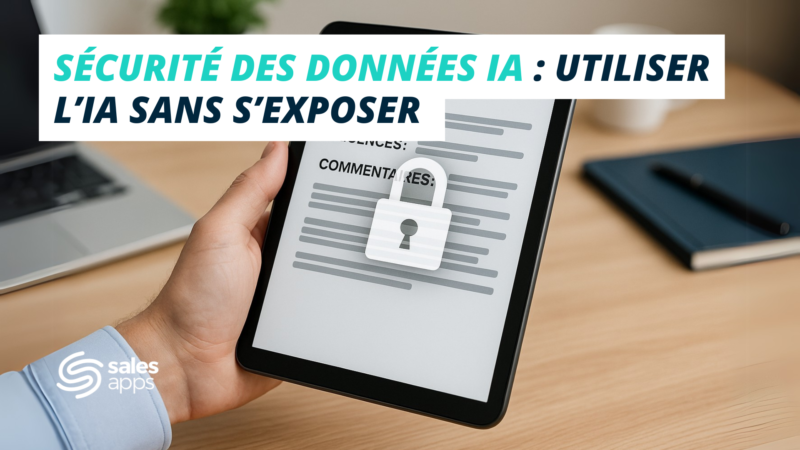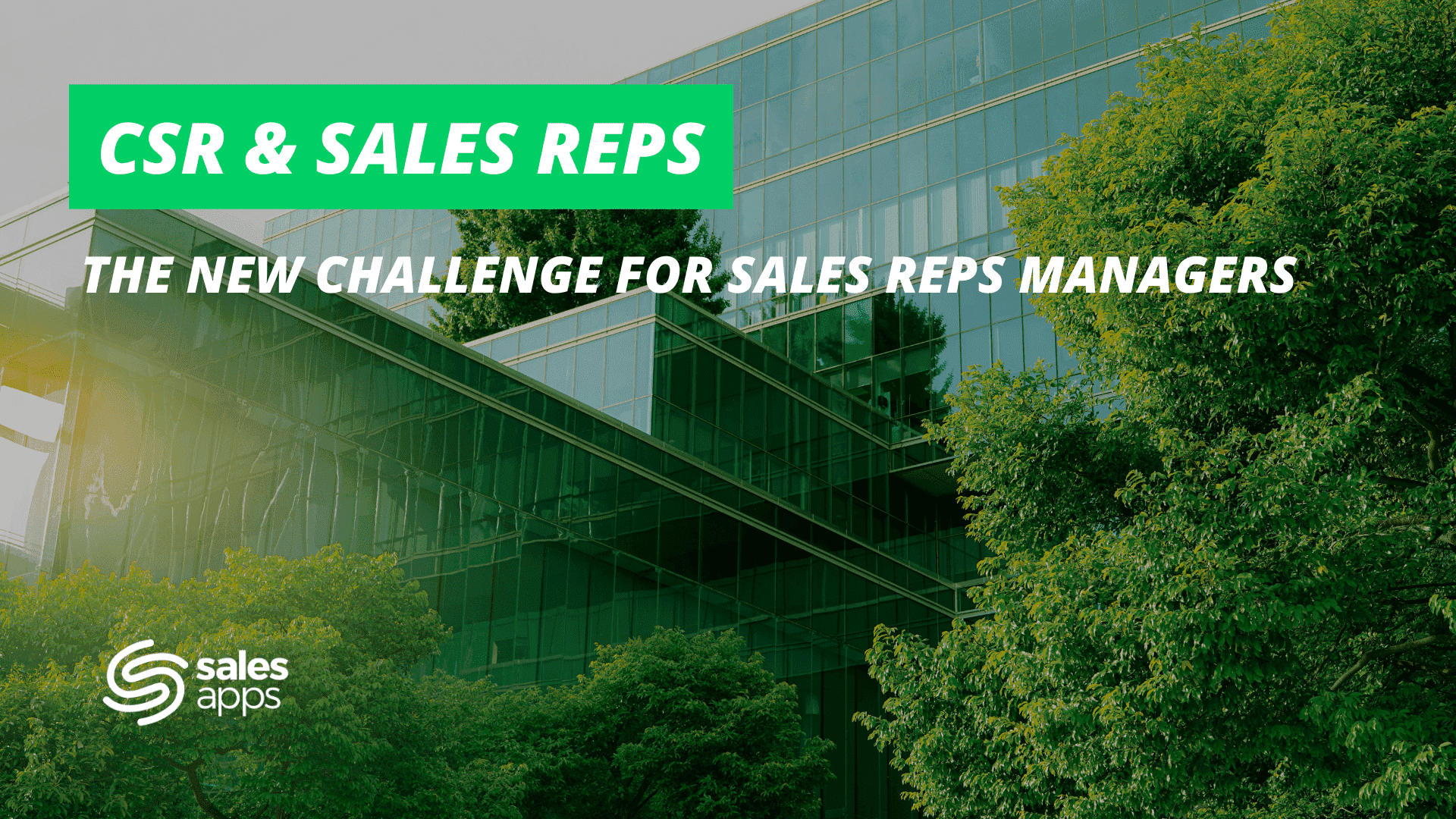
Blog
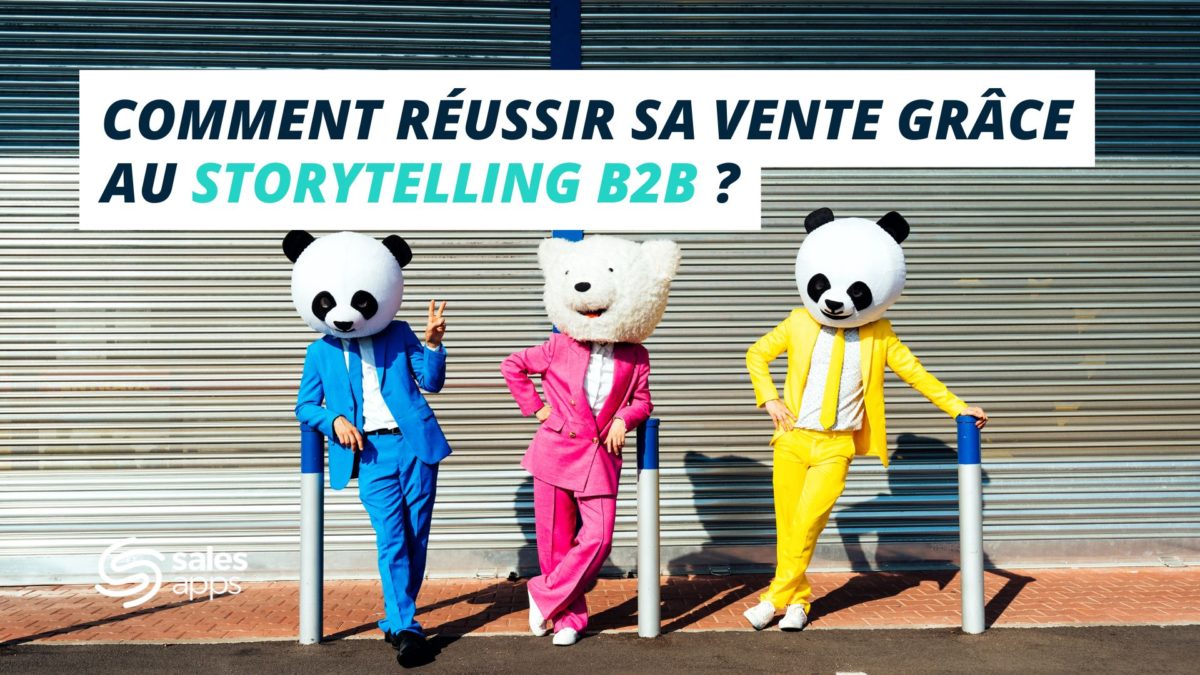
In today's highly competitive b2b sales environment, it's becoming a real challenge for sales reps to stand out from the crowd. How do you make an impression on the buyer? How do you capture their attention from the very first moments of the meeting, and maintain their interest throughout? These questions bring us to an essential point: how do you sell successfully in front of the buyer? According to a study by Havas Paris, 65% of buyers are more likely to purchase a product when they have been convinced by a brand's story. B2B storytelling is an effective way of meeting these challenges, and of giving greater impact to the sales pitch.
B2B storytelling: definition and why use it?
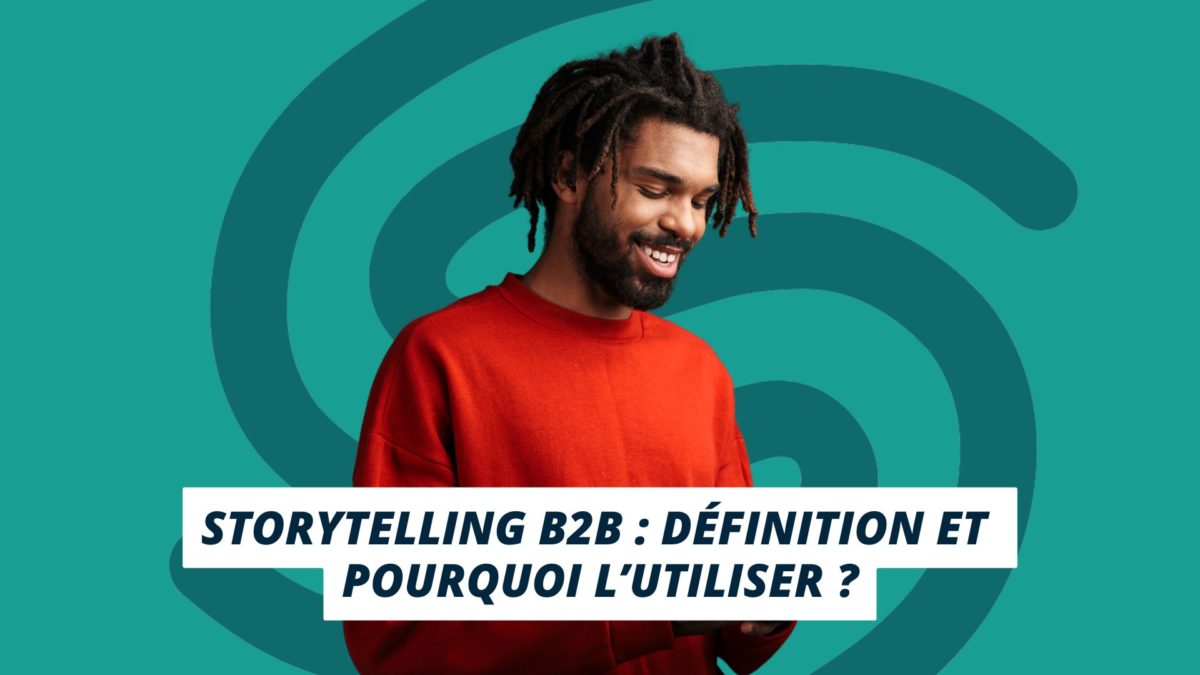
1 - What is Storytelling?
Storytelling is the art of telling a story to create an emotional bond with the buyer. In a B2B sales context, this link is crucial, as it can significantly increase the conversion rate of your appointments. A study conducted by Google, in partnership with Motista and CEB, reveals that 50% of B2B buyers are more likely to buy when they feel emotionally connected to a brand. Rather than a traditional pitch focused solely on the technical features of the product or service, storytelling builds a narrative that resonates with the buyer's needs, aspirations and challenges. This emotional connection then becomes a key lever for positively influencing the purchasing decision, transforming a simple sales presentation into a memorable and persuasive experience. Storytelling is all the more important as integrating this method into the sales pitch helps to improve the rate at which information is memorized. A study by Brain Sciences points out that stories are 22 times more memorable than facts and figures alone.
2 - Why is it important in B2B sales?
Given that the average B2B buyer spends only 17% of his or her time interacting with sales reps, and barely 5% when drawing up a shortlist (Gartner), it's legitimate to ask how a sales rep can differentiate himself or herself in such a context. It's essential to capture the buyer's interest quickly and maintain it throughout the sales pitch. Storytelling, by making information more attractive and memorable, proves to be an essential sales technique for attracting and holding attention in this limited time.
How can B2B storytelling improve my sales reps results?
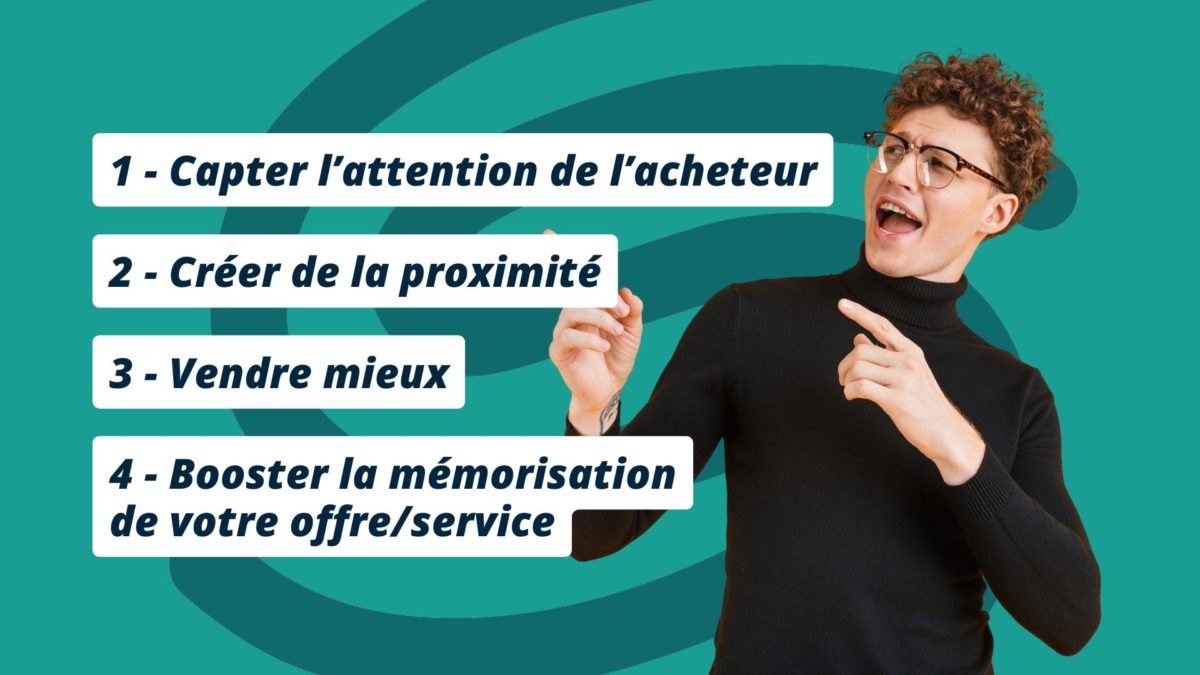
1 - Storytelling helps capture the buyer's attention
As we saw earlier, the salesperson's influence time has shrunk... yet the value expected from appointments has never been higher. The salesperson must now be able to convince within a limited timeframe. Capturing the buyer's interest right from the start of the meeting has become a real challenge for sales reps. Storytelling is proving to be a powerful technique for overcoming this obstacle. By telling a captivating story, you can capture the prospect's attention from the very first seconds and maintain their interest throughout the presentation. A well-constructed story has the power to transform a sales presentation into an engaging experience, making your exchanges more dynamic and memorable.
2 - Storytelling creates proximity
One of the key strengths of B2B storytelling is its ability to humanize sales interactions. By sharing authentic stories that resonate with the buyer's experiences and challenges, the salesperson can establish a bond of trust and closeness. This approach not only makes communication flow more smoothly, but also creates an emotional connection that fosters empathy and mutual understanding. By feeling understood and valued, the buyer is more inclined to commit to the business relationship and to look favorably on the proposal made.
3 - Storytelling helps you sell better
Storytelling doesn't just embellish your sales pitch, it directly influences the course of the sale. A recent study by the Stanford Graduate School of Business revealed that storytelling can increase conversion rates by up to 30%. By using B2B storytelling to highlight your brand story or those of your customers, you create a bond with the buyer while reinforcing the added value of your offer/service. Not only is this type of communication more persuasive, it also increases the impact of your message by making it more relevant to the buyer's specific needs.
4 - Storytelling boosts the memorability of your offer/service
B2B storytelling has a direct impact on the memorability of information. Statistics alone have a memorization rate of 5-10%, but when combined with anecdotes, this rate rises to 65-70%, according to a Stanford study. A study by Brain Sciences corroborates this statistic: stories are 22 times more memorable than facts and figures alone. By incorporating stories into your presentations, you significantly increase the chances that your message will stick in the buyer's mind, increasing the likelihood of conversion.
How do you create a good B2B story?
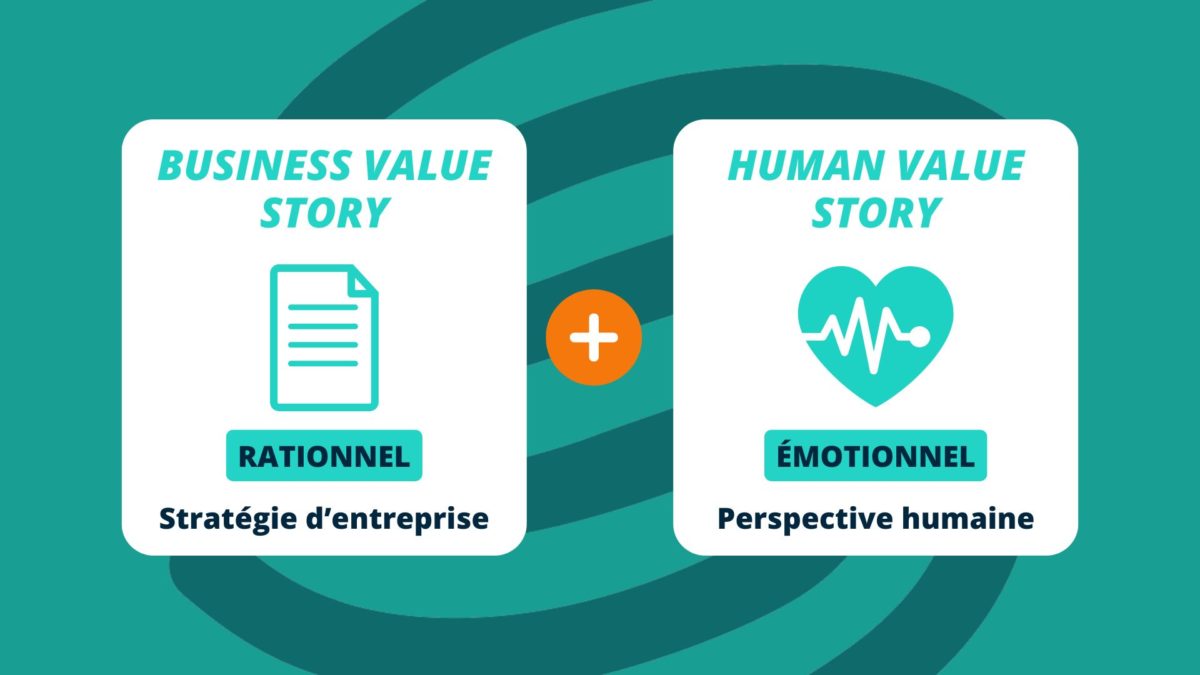
Storytelling is a powerful lever for creating lasting impact, not only by being effective, but also by emotionally touching your audience. In the commercial context, successful B2B storytelling relies on the combination of two elements, which Gartner calls "Business Value Story" and "Human Value Story" respectively.
The Business Value Story is based on concrete data that demonstrate the long-term effectiveness of your product or service. It shows how a customer's investment translates into visible performance indicators, proving that they get what they pay for. However, to maximize the impact of your message, it's crucial to add a human dimension: the Human Value Story. This second element focuses on the real-life experiences of people who have benefited from your product or service. It highlights the positive emotional results these customers have achieved, reinforcing your ability to influence your prospect. By combining these two types of storytelling, you create a more compelling and memorable narrative. The buyer is no longer just exposed to rational arguments; he is also moved by stories that show him that others, like him, have found satisfaction and success thanks to your solution. This adds a dimension of social proof that reassures and encourages action.
Finally, for your story to have real impact, it's essential to focus on real people, not anonymous or generic users. It's the individual, concrete experiences that will make all the difference to your storytelling.
The narrative framework of good B2B storytelling
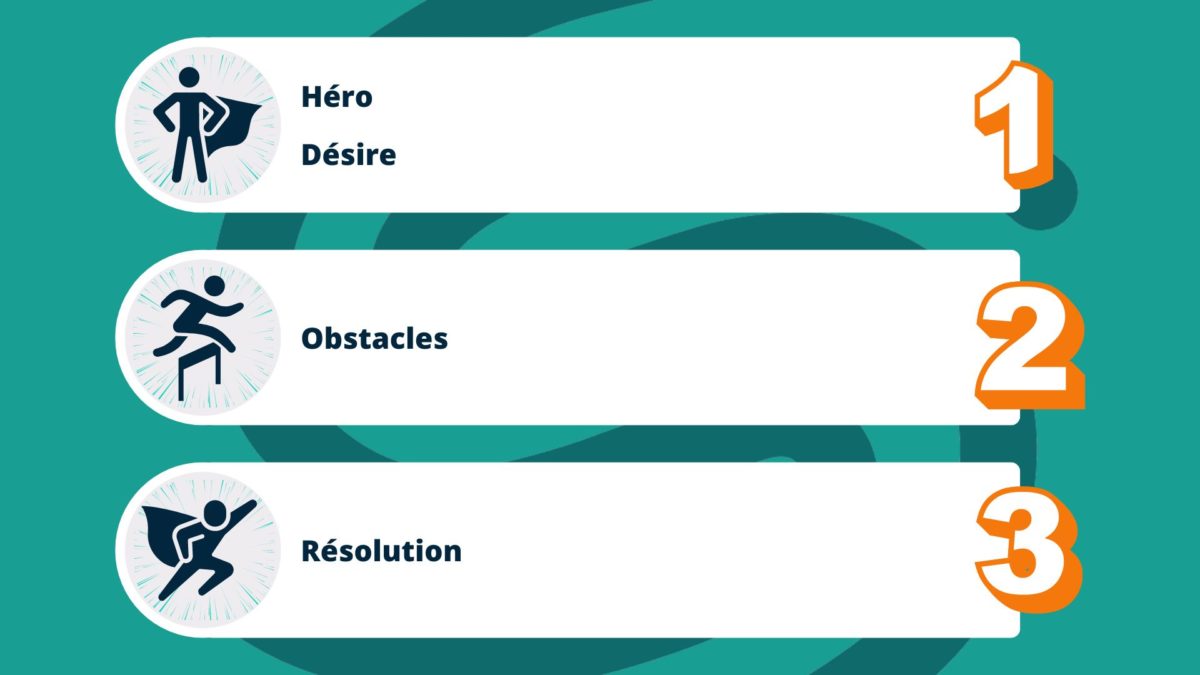
Good B2B storytelling follows a clear structure, often inspired by the classic "hero's journey" narrative scheme. This approach enables you to create a captivating story that resonates with your audience, highlighting your customers' challenges and successes, while emphasizing the added value of your product or service. Here are the key stages of this narrative scheme, illustrated by an example of storytelling:
1 - Heroes & Desire
Each story begins with a hero who embodies your ideal customer. This hero represents a company or a decision-maker faced with a specific need or desire. This desire could be to improve the commercial efficiency of their team, to solve a problem, or to innovate in a competitive market. The aim is to get your audience to identify with this hero from the very start of the story, by sharing similar concerns or aspirations.
Example: We met Jean, Sales Director at X, at the N trade show in 2020. His objective was ambitious: to increase sales by 10% this year.
2 - Obstacles
Then comes the obstacle stage, where the hero faces various challenges that prevent him from reaching his goal. These obstacles are crucial because they create the narrative tension needed to capture attention. In the B2B context, these obstacles can be market challenges, budget limitations, or internal inefficiencies.
This is where your product or service comes in as a potential solution. The aim is to show how these obstacles slow down or block the hero's progress, and how your solution could be the key to overcoming them.
Example: As we delved deeper into his project, we quickly identified that his sales team lacked efficiency, spending too much time on low-value-added tasks.
3 - Resolution
Finally, resolution is when the hero, thanks to your product or service, overcomes the obstacles and achieves his or her goals. This stage shows the tangible results of using your solution, whether in terms of increased sales, improved customer satisfaction, or reduced costs.
The resolution fulfills the promise made at the beginning of the story: not only does the hero achieve his initial desire, but he is also transformed by the experience. It's this positive transformation that leaves a lasting impression on your audience, encouraging them to seriously consider your solution to their own challenges.
Example: After six months using the application, Jean is fully satisfied with the Salesapps team's support and the solution implemented for his sales team. The results are there for all to see: a 5% increase in sales in the first quarter, a significant improvement in sales processes with customer appointment preparation time divided by 2, and visit reports automatically fed into the CRM. Jean will be doing a REX with us next month. I think it would be interesting for you to attend. Can I save you a seat?
To make your B2B storytelling more authentic and credible in the eyes of the buyer, it's essential to add details that contextualize your story. Don't underestimate the power of emotion in your storytelling, as it's emotions that create an engaging experience for the buyer, strengthening your connection with them.
5 principles to maximize the impact of your B2B storytelling
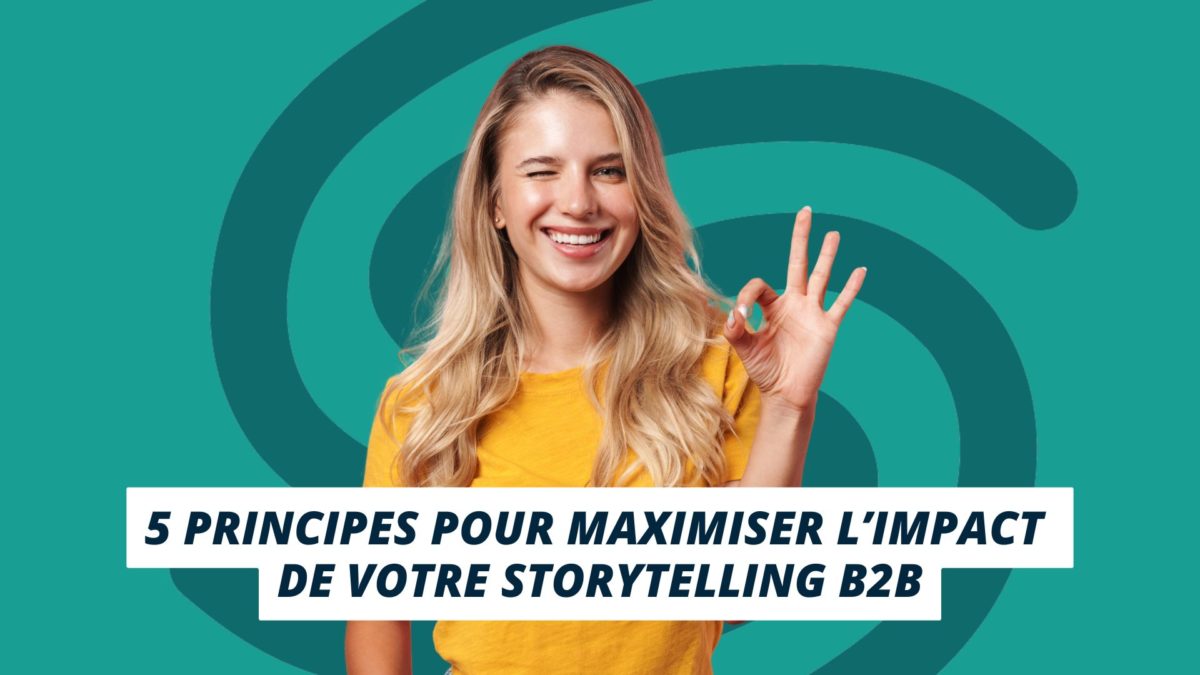
Storytelling is more than just verbal narration. It relies on a diversified, agile content strategy, capable of captivating, informing and convincing the buyer. To be truly impactful, B2B storytelling must integrate different formats, adapt to the needs of each interlocutor, and ensure consistency in the way information is presented by the salesperson. Each element must enrich the story and reinforce the effectiveness of the discourse. Here are the essential principles for maximizing the impact of your storytelling:
1 - The importance of using visuals in your storytelling content
The impact of visuals in your marketing content is undeniable when it comes to strengthening your B2B storytelling. As the saying goes, "a picture is worth a thousand words". Visuals play a crucial role in storytelling. They make your message easier to understand and more robust. A well-chosen visual captures the buyer's attention and encourages more immediate adherence to your message.
2 - Navigation adapted to each contact
Storytelling must be flexible and adaptable to the context of each sales meeting. Depending on the profile or stage of the buying journey, sales reps need to be able to choose different types of content to contextualize and visually enrich their approach. This enables them to adjust their narrative more easily, and to be more responsive in their answers to questions from buyers and stakeholders.
3 - The flexibility of storytelling content
A good narrative must be based on flexible content, capable of adapting to the context of the meeting. This content must be designed to facilitate the exchange with the buyer without weighing down the meeting. For example, a 10-slide presentation may be more appropriate for a customer lunch, as it enables the sales rep to quickly illustrate his or her points, whereas a more formal meeting may require a longer format, adapted to the length of the exchange. Offering salespeople this flexibility enables them to remain spontaneous in their approach and maintain a dynamic focused on creating value for their buyer.
4 - The interconnection and complementarity of storytelling content
Effective B2B storytelling is not about repeating the same information in different formats, but about creating content that complements and enriches each other. The interconnection between these contents helps deliver a coherent message while avoiding redundancy. For example, a sales rep might enrich his presentation with a shorter format (10 to 15 slides) to illustrate a customer case. The idea is that each piece of content adds a new dimension to the story, reinforcing the clarity and effectiveness of the sales pitch - without drowning the buyer in repetitive information.
5 - Storytelling training
If a salesperson is to be able to adapt his or her message to the person he or she is talking to, it's vital that he or she has a good grasp of the different topics covered. This requires ongoing training, particularly on more complex or technical subjects. The salesperson must be able to adjust his or her storytelling to the audience's level of understanding, and be able to simplify certain aspects or, on the contrary, go into technical detail. Effective B2B storytelling needs to be adapted to each meeting, and this requires careful preparation. Training is therefore a key element in this process.
Sales Enablement to strengthen your B2B storytelling approach

The Sales Enablement application modernizes your sales approach by optimizing the management of your content in the document base. In addition to integrating marketing content into intuitive sales paths, it allows you to adjust these paths according to the content itself. This disruptive approach takes the personalization of your sales approach one step further, giving you the ability to position entry points wherever you like in your marketing content. In a way, your content adapts to your storytelling, enabling you to reinforce your narrative during meetings with the buyer. Thanks to story design for your marketing content, you can enhance your oral narrative and maximize its impact.
1 - Capture buyers' attention with immersive, contextualized sales paths
The Sales Enablement application enables you to integrate rich, dynamic content that immediately captures the buyer's interest. Effective B2B storytelling, coupled with powerful visuals, allows you to immerse buyers in a world that speaks to them, making your message both relevant and captivating.
2 - Encourage your buyers to listen actively
Effective storytelling doesn't just tell a good story; it invites interaction. Animated in-app marketing content transforms a simple presentation into an engaging experience. The buyer becomes not only more attentive, but also actively involved during the appointment.
3 - Host interactive meetings
Sales Enablement transforms your meetings into truly collaborative sessions. Thanks to the story design of your content, you immerse the buyer in an immersive, interactive experience where they can interact with the app, making exchanges more dynamic and participative. You might even be surprised to see your buyer playing with your tablet and starting to explore the app.
4 - Boost your appointment conversion rate
By combining story design in your content and B2B storytelling in your sales pitch, you maximize your chances of conversion. A well-constructed narrative, supported by engaging and interactive content, not only captures the buyer's attention, but also reinforces the impact of your sales pitch.
Join Salesapps ENGAGE, to be informed of our upcoming events.
FAQ
What is storytelling?
Storytelling is the art of telling a story to establish an emotional connection with the audience, using captivating narratives to convey key messages.
Why use storytelling in b2b sales?
It's a communication technique for creating an emotional connection with buyers, increasing engagement and conversion rates, by making offers more memorable and compelling.
How can I measure the impact of storytelling on my sales?
Track KPIs such as conversion rates, customer engagement, sales cycle times and return on investment (ROI).
How can I train my sales team in storytelling?
Organize hands-on workshops, offer case studies, and encourage regular practice to integrate storytelling into their sales presentations.
How can I make a good story?
There are many different storytelling techniques, the best-known of which is the "hero's journey". By following this narrative pattern, you can give your story impact and reinforce your influence with the buyer.

